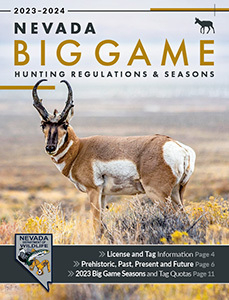The Sagebrush State Needs Your Help

By the Habitat Division
Nevada is officially known as the “Sagebrush State” and while this olive-green shrub may appear unassuming, the sagebrush ecosystem is remarkably diverse. Sagebrush ecosystems span much of the western United States and host over 350 species of plants and animals. To sustain these shared values for current and future generations, we must recognize the challenges facing our sagebrush habitats.
Sagebrush now occupies less than 55 percent of its historical extent with many associated species in decline. Over the last 20 years, the West has lost about 1.3 million acres of high-value sagebrush habitat annually. The loss and degradation of sagebrush habitat is occurring at a rapid rate across the western U.S. and particularly in Nevada.
The dramatic decline of sagebrush habitat distribution and health is related to many threats and challenges, such as invasive plant species, wildfire, climate change, conifer expansion, overabundant free-roaming horses, human related expansion. Invasive species and wildfire are particularly damaging in Nevada, where over 13.2 million acres have burned in the last 30 years. The frequency and size of these fires is steadily increasing, and natural recovery of sagebrush or grassland habitat is often severely limited by annual grasses such as cheatgrass. These changes lead to less and poorer-quality sagebrush habitat available for wildlife. Nevada’s wildlife depends on healthy plant communities for food, water, cover, space, and connectivity between summer and winter use areas. Without healthy plant communities to provide food and cover, wildlife populations will continue to decline.
Many of Nevada’s habitats no longer provide the necessary and diverse structure, cover, and forage resources for wildlife they once did. Even in areas where sagebrush still dominates, many of the plants are in decline and the diverse grasses and forbs that were once present have been lost. Wildlife, such as mule deer, are dependent upon these lower elevation habitats during the winter months. The toll these degraded habitats have on wildlife can be particularly harmful during tough winters. When these habitats no longer possess the characteristics necessary to provide food and cover through the winter, species like mule deer and pronghorn can no longer survive.
The Nevada Department of Wildlife, with help from numerous conservation partners, as well as federal, state, and local agency partners, take an active role in rehabilitating and restoring critical wildlife habitat to combat these challenges. Since 2017, NDOW has invested over $11.7 million dollars to implement 570,609 acres of wildfire rehabilitation and restoration treatments. Additionally, we have treated 44,831 acres of pinion-juniper in encroached sagebrush habitat at a cost nearly $4.2 million, and spent over $1.9 million to protect and enhance 1,680 acres of spring, riparian, and meadow habitats. Even under ideal circumstances, it can take many years for sagebrush habitats to recover.
Despite these great partnerships and efforts, Nevada continues to lose habitat and wildlife. Given this challenge we are working continuously to focus conservation efforts that protect, grow, and connect core habitats. The Nevada Sagebrush Habitat and Wildlife Connectivity Plans, which are currently being developed, will be linked to a west-wide effort known as the Sagebrush Conservation Design. These efforts will provide new mapping tools to ensure conservation efforts and dollars are invested strategically in the highest-reward areas. Refocusing our management approach to protect, grow, and connect core habitats will help in many ways, but the scale, vastness, and competing demands on Nevada’s landscape will continue to create challenges.
As you head to the field, we ask that you recognize the challenges facing the sagebrush ecosystem and ask yourself how you can support Nevada’s wildlife habitat. Support can come in many forms, such as reducing and eliminating human caused wildfires by keeping vehicles on existing and designated roads and taking precautions not to spread weeds. Additionally, consider joining a conservation organization with financial or time contributions towards wildlife and habitat conservation.
Lastly, help us explore new partnerships, and opportunities to increase our capacity to implement on-the-ground projects, and increase our capacity to grow conservation programs. By increasing the number and size of our habitat projects, we can have healthy habitats and wildlife populations for years to come.


